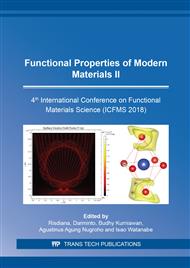p.30
p.35
p.41
p.48
p.54
p.60
p.66
p.72
p.77
Characterization of BaM and PaNi-Based Radar Absorbency (RAM) Behavior with Multilayer Geometry Structure for X-Band Absorption
Abstract:
Behavioral characterization of radar absorbent material consisting of Polyaniline (PaNi) and Barium M-Hexaferrite (BaM) has been successfully synthesized by solid state method. Polyaniline conductive material was synthesized using the polymerization method with DBSA dopant. A Radar Absorbing Materials (RAM) is characterized by X-Ray Fluorescence (XRF), X-Ray Diffraction (XRD), Fourier Transform Infrared (FTIR), Four Point Probe (FPP), Scanning Electron Microscope (SEM) and Vector Network Analyzer (VNA). The ion Zn 2+ is dopping into the BAM structure, where Zn 2+ ions replace Fe2+ ions in Hexaferrite barium so that the phase becomes soft magnetic materials . RAM and PANi particles are combined with ship paint to form radar wave absorbent coatings. The layer is coated with multilayer geometry on AH 36 type A steel, with thicknesses of 2.4 mm, 3.6 mm, 4.8 mm and 6 mm respectively. The X-band wave absorption was identified by VNA testing, where the maximum reflection loss value was found at 6mm thickness with a reflection loss value - 32.6 dB at 8.4 GHz frequency. Reflection loss values of multilayer variations with a thickness of 2.4 mm, 3.6mm and 4.8mm each have reflection loss values of -8.02 dB, -19.13 dB and -28.9 dB respectively in the x band frequency range.
Info:
Periodical:
Pages:
54-59
Citation:
Online since:
August 2019
Authors:
Keywords:
Price:
Сopyright:
© 2019 Trans Tech Publications Ltd. All Rights Reserved
Share:
Citation:


